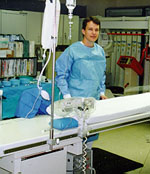'Controlled heart attack' reconditions failing heart
 Dr.
Christopher D. Nielsen
Dr.
Christopher D. Nielsen
Last Friday, Oct. 22, for the first time in South Carolina, an MUSC cardiologist induced what can be likened to a carefully controlled heart attack to treat a patient's life-threatening heart condition.
Forty-one-year-old Linda Hodges of McCormick, S.C., was constantly out of breath, virtually homebound, and faced frequent hospitalization from a condition called hypertrophic obstructive cardiomyopathy.
Christopher D. Nielsen, M.D., used a catheterization procedure to destroy portions of thickened muscle in Hodges’ heart which obstructed blood flow to vital organs of her body and caused a fluid build-up in her lungs.
Two days after the procedure, she was released from MUH and returned home to McCormick. Three days later she reported to Nielsen that she was feeling fine and was no longer experiencing shortness of breath.
Hypertrophic obstructive cardiomyopathy may affect as many as one in a thousand people. Some have mild cases, and can live with the condition for many years without symptoms and may never be diagnosed.
“Patients with this condition develop a thickening of the septum, the muscle dividing the two ventricular chambers of the heart,” explained Nielsen. “The muscle gets so thick that it covers most of the opening through which blood is normally pumped out to the rest of the body. The body’s vital organs, therefore, do not receive adequate blood flow. Also, because the blood cannot be pumped out, it backs up into lungs, causing a fluid build-up in the lungs. This makes the patient out of breath, sometimes even at rest, but always with exercise.”
This is often the underlying disease in the seemingly healthy athletes who suddenly die during strenuous exercise. Others have symptoms, but the symptoms can be effectively controlled by medication or implantation of a pacemaker. For those who have serious symptoms not controllable by medication or a pacemaker, an invasive open heart surgery is an option.
In recent years, William Spencer, M.D., of Baylor Heart Clinic in Houston refined a procedure developed in Europe and performed it successfully on more than 100 patients. He has trained cardiologists from several centers nationwide, including Nielsen at MUSC.
Hodges’ condition reached the point where her quality of life deteriorated to an unacceptable level. Her medications were not working, and the open heart surgery option was deemed too risky. She was referred to Spencer at Baylor, who in turn referred her to Nielsen so she could be under the care of a cardiologist in her own state.
Non-surgical septal reduction therapy is a method of eliminating the obstruction without open heart surgery. The traditional surgical procedure involves opening up the chest cavity and actually shaving off a piece of the septum so the outflow is no longer obstructed. With the new procedure, a catheter is inserted in the femoral artery, and tubes are run up to heart. The specific artery leading to the area of the thickened septum is located, and alcohol is injected through the catheter. Immediate death to the cells in that area results.
“This effectively rids the septum of the thickened cells, shrinking the area,” explained Nielsen. “ It is in effect, a small, but highly controlled heart attack in this area of the septum. We can actually see the small area stop contracting.” As time passes scar tissue is formed and it shrinks down and thins out so the obstruction remains gone. There is a sustained benefit. If it works well at time of procedure, the benefit appears to be sustained. In fact, Spencer has just had a paper accepted for publication in a respected cardiology journal where he reported follow-up on patients more than a year after the procedure. He found that there were no late adverse effects in these patients and the initial improvement in heart function was sustained in almost all of the patients.
“At the moment, this procedure is not the standard of care and it is
done under a rigorous research protocol,” said Nielsen, an assistant professor
of cardiology and director of interventional cardiology. “The data certainly
indicates that this is an effective treatment, and we expect this to be
the procedure of choice for this condition. In Ms. Hodges’ case, it was
extremely successful. It, in essence, not only offers her hope for long-term
survival, but promises a dramatically improved quality of life.”